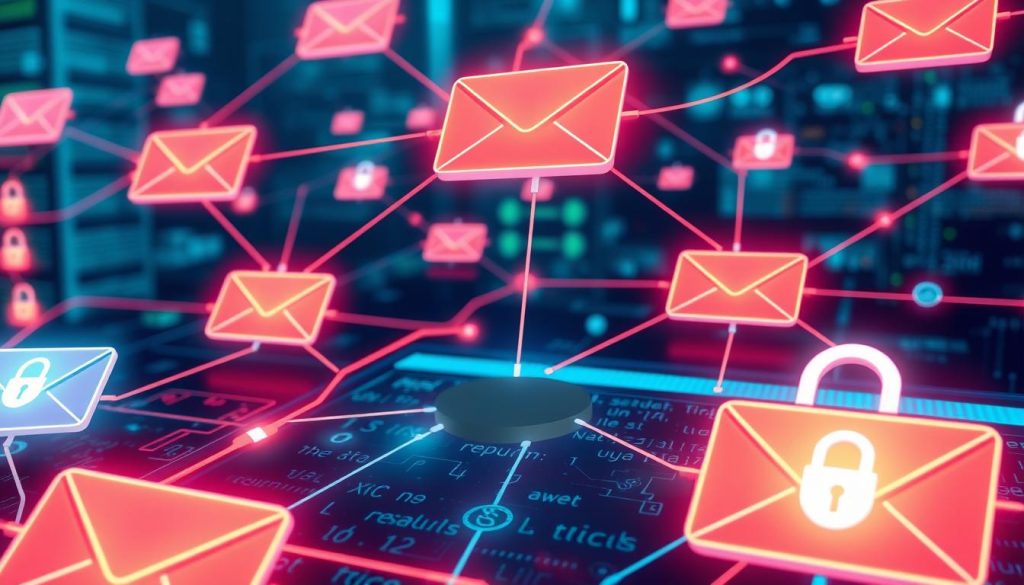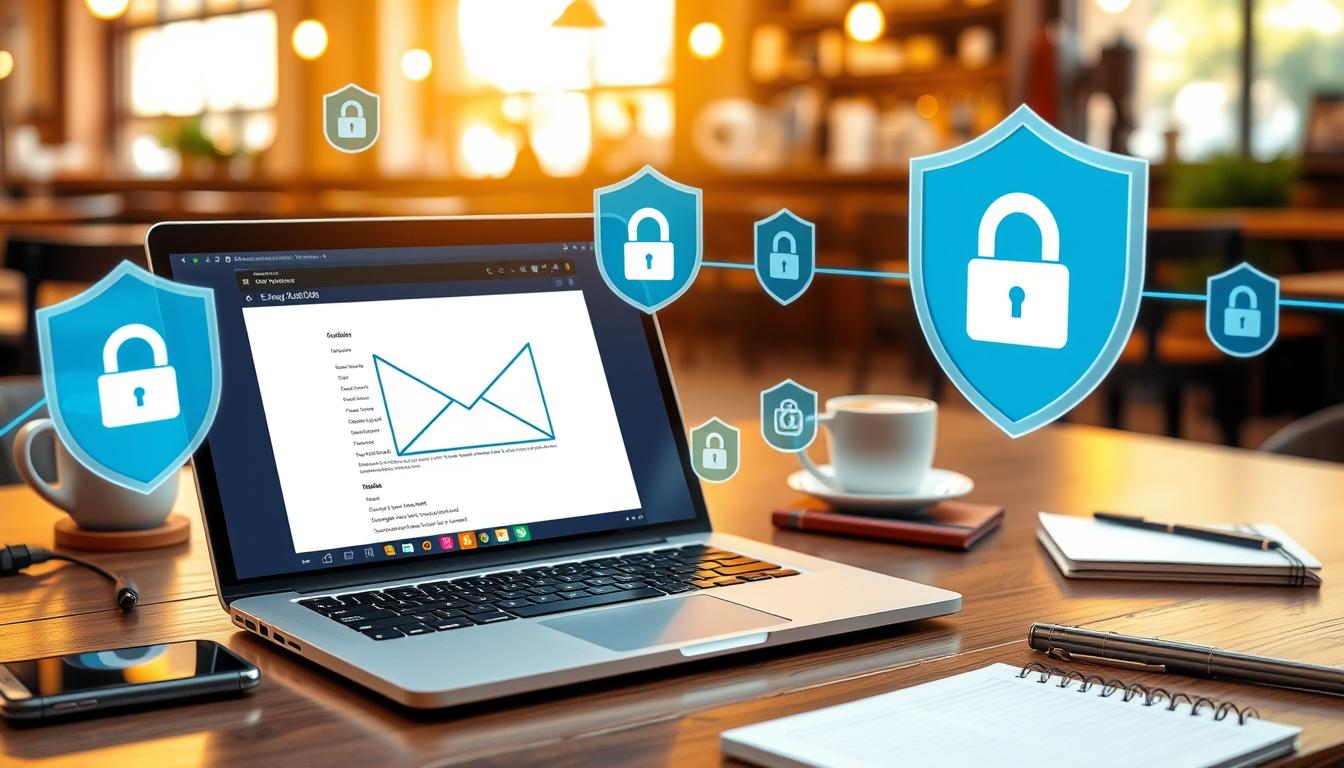Did you know 63% of emails never reach their recipient’s inbox? This shows how vital email authentication is for cold email campaigns. Sender Policy Framework (SPF), DomainKeys Identified Mail (DKIM), and Domain-based Message Authentication, Reporting and Conformance (DMARC) are key. They help your emails reach the right people.
In cold email, making a good first impression is crucial. If your emails go to spam, you miss your chance to make an impact. So, it’s key to use these authentication methods. They boost your sender reputation and help your emails land in the inbox, leading to better results.
Key Takeaways
- SPF, DKIM, and DMARC are email authentication protocols that enhance email delivery and prevent spam and phishing attacks.
- Implementing these protocols can significantly improve your email deliverability and sender reputation.
- SPF and DKIM work together to verify the source of your emails, while DMARC aligns your domain addresses and specifies how to handle unauthenticated messages.
- Setting up these protocols may require adding specific records to your domain’s DNS settings, but tools are available to simplify the process.
- Failure to implement email authentication can lead to your messages being marked as spam, especially for larger organizations.
Introduction to Email Authentication Protocols
Businesses are now focusing more on improving their cold email campaigns. This is why email authentication protocols are key. Sender Policy Framework (SPF), DomainKeys Identified Mail (DKIM), and Domain-based Message Authentication, Reporting, and Conformance (DMARC) are the main protocols. They work together to check if emails are really from the sender, making your messages more reliable and trustworthy.
The Importance of Email Authentication for Cold Email Campaigns
Email authentication is crucial for better cold email campaigns. It proves you’re the real sender, building trust with the recipient’s server. This means your emails are more likely to land in the inbox, not the spam folder.
An Overview of SPF, DKIM, and DMARC
- Sender Policy Framework (SPF): SPF lets domain owners say who can send emails for them. It stops email spoofing and helps your emails get delivered.
- DomainKeys Identified Mail (DKIM): DKIM uses secret codes to check if the email is from the right sender. It makes sure the message is safe during its journey.
- Domain-based Message Authentication, Reporting, and Conformance (DMARC): DMARC is built on SPF and DKIM. It tells how to handle emails that don’t pass checks and gives reports on your domain’s email security.
Using these email authentication protocols can really boost your cold email campaigns. It leads to more successful outreach and better connections with your audience.
Understanding Sender Policy Framework (SPF)
The Sender Policy Framework (SPF) is key in email authentication. It checks if an email sender is legitimate. SPF stops spammers from using fake “From:” addresses. It keeps your emails safe and your domain’s reputation strong.
What is SPF?
SPF is a simple way to make sure emails are from who they say they are. It lets domain owners say who can send emails for them. This way, emails from fake sources get blocked, keeping spam and phishing away.
How to Set Up SPF Records
- Start by creating a TXT record in your DNS settings that begins with “v=spf1”.
- Within the TXT record, list the IP addresses or hostnames that are authorized to send emails from your domain.
- Use qualifiers like “~” (SoftFail), “-” (Reject), “+” (Pass), and “?” (Neutral) to specify how the receiving server should handle emails that don’t match the authorized sources.
- Keep your SPF record up-to-date as you add or remove email senders to ensure maximum deliverability and protection against spam.
With a strong SPF record, you boost domain authentication, email deliverability, and spam prevention. This improves your sender reputation.
Implementing DomainKeys Identified Mail (DKIM)
DKIM, or DomainKeys Identified Mail, is a key email authentication protocol. It checks if a message’s content has been changed after sending. This makes your emails more trustworthy to mailbox providers. Setting up DKIM is essential for a strong email authentication system, along with SPF and DMARC.
To start with DKIM, you need to create a public and private key pair. You can use PUTTYGen for Windows or ssh-keygen for Linux and Mac. After getting the keys, add the public key as a TXT record in your domain’s DNS. This lets the receiving server check your emails’ digital signatures.
Next, choose which email fields to include in the DKIM signature. You might pick “From,” “Subject,” and “Date” headers. The DKIM signature is a hash value encrypted with your private key. The receiving server can then decrypt it with your public key to confirm the message’s integrity.
| Key Benefit | Percentage Improvement |
|---|---|
| Enhances email deliverability | Up to 20% increase |
| Ensures message integrity | 100% guarantee against tampering |
| Boosts email security | Significant reduction in phishing and spoofing attempts |
DKIM is vital for making your email authentication stronger. It helps improve your cold email campaigns’ deliverability and trustworthiness. By setting up DKIM correctly, you show mailbox providers that your emails are genuine and should reach their intended recipients.
Domain-based Message Authentication, Reporting and Conformance (DMARC)
DMARC is key in email authentication. It boosts email delivery and fights email scams. It works with SPF and DKIM to check if emails are real.
The Role of DMARC in Email Authentication
DMARC helps by letting domain owners control how emails are handled. They can set rules for emails that don’t pass checks. This stops fake emails from using their domain.
Setting Up DMARC Records
To start with DMARC, add a TXT record to your DNS. This record has your policy, how many emails to check, and who gets reports. It helps keep your brand safe and protects your customers.
| DMARC Policy | Description |
|---|---|
| p=none | Indicates that the domain owner is only monitoring email authentication and not enforcing any specific policy. |
| p=quarantine | Instructs the receiving mail server to move messages that fail DMARC authentication to the spam or junk folder. |
| p=reject | Directs the receiving mail server to reject messages that fail DMARC authentication, preventing them from reaching the recipient’s inbox. |
Using DMARC makes emails more reliable and trustworthy. It also keeps your brand and customers safe from scams.
The Role of Email Authentication (SPF, DKIM, DMARC) in Cold Email Deliverability
Using SPF, DKIM, and DMARC is key to better cold email delivery. These tools help your emails get past spam filters and into the inbox. By authenticating your emails, you show you’re a trusted sender. This improves your domain’s reputation and boosts cold email success.
SPF lets domain owners list allowed IP addresses for sending emails, stopping spoofing. DKIM adds a digital signature to emails, ensuring they’re genuine. DMARC works with SPF and DKIM, telling how to handle unverified emails.
Starting February 2024, Google and Yahoo will have new rules for bulk email. Senders of over 5,000 emails a day must use SPF, DKIM, and DMARC. Without these, your emails might end up in spam or not get sent at all.
| Authentication Protocol | Description |
|---|---|
| SPF | Verifies the sender’s IP address against a list of authorized senders in a DNS TXT record. |
| DKIM | Adds a digital signature to emails, ensuring the integrity and authenticity of the message content. |
| DMARC | Builds on SPF and DKIM, allowing domain owners to specify how to handle unauthenticated emails. |
Using these email authentication tools can help your emails avoid spam filters. This improves your inbox placement and domain reputation. It makes your cold email campaigns more successful.
“Effective email authentication is not just a best practice; it’s becoming a requirement for successful cold email deliverability.”
Improving Sender Reputation with Email Authentication
Keeping a good sender reputation is key for cold email success. Using email authentication like SPF, DKIM, and DMARC is a top way to do this. These methods prove you own your domain and show emails are real and from you.
This boosts your email sender reputation. It also means your emails are more likely to land in the inbox, not the spam folder.
The Impact of Sender Reputation on Inbox Placement
Your domain reputation affects how well your emails get delivered. ISPs keep track of IP addresses and domains. They update these scores based on how you send emails and how people interact with them.
A good sender reputation, shown by scores like Sender Score, helps your emails get to the inbox. But a bad reputation can send them straight to spam. This hurts your cold email success.
| Metric | Value | Impact on Deliverability |
|---|---|---|
| Sender Score | 0-100 | Higher scores mean better email sender reputation and more inbox placement |
| Spam Rate | 49% | Almost half of emails are spam, showing how important email authentication and spam prevention are |
| Deliverability Rate | Below 95% | A low deliverability rate can cause more bounces and email deliverability problems |
By using email authentication and keeping a strong sender reputation, you can get more emails to the inbox. This makes your cold email campaigns more effective.

Best Practices for Email Authentication
Using strong email authentication like SPF, DKIM, and DMARC is key for your domain’s health. It also helps your cold email campaigns reach more people. By following the best practices, you can make sure these methods work well.
It’s vital to have only one SPF and one DMARC record for your domain. This avoids any mix-ups. Also, creating strong DKIM keys is crucial for proving your emails are real.
- Ensure you have a single SPF record and a single DMARC record configured for your domain.
- Generate robust DKIM keys to enhance the verification process.
- Consider starting with a “p=none” DMARC policy before gradually transitioning to a more restrictive “p=quarantine” or “p=reject” policy.
Setting up and keeping these email authentication methods right can really help your domain’s image. It also makes your cold email campaigns more successful. By sticking to the best practices, your emails will be seen as genuine and reliable. This boosts your email deliverability and campaign success.
“Implementing email authentication best practices is essential for maintaining a positive domain reputation and maximizing the reach of your cold email efforts.”
Effective email authentication depends on careful setup, constant checking, and quick updates to your SPF, DKIM, and DMARC records. By doing this, your domain stays in good shape. And your cold emails will get to where they need to go.
Monitoring and Troubleshooting Email Authentication
After setting up SPF, DKIM, and DMARC, it’s key to keep an eye on how they’re doing. A good email authentication system is vital for your domain’s safety and cold email success.
Tools and Resources for Email Authentication Monitoring
There are many tools and resources to help you watch your email authentication and fix any problems. Here are a few:
- MXToolbox – A suite of tools for checking SPF, DKIM, and DMARC, and finding any errors.
- Proofpoint – A top email security provider that monitors DMARC and reports on your domain’s email health.
- Easy DMARC – A platform that makes it easy to set up, monitor, and fix DMARC records.
By regularly checking the reports from these tools, you can spot and fix any email authentication monitoring or troubleshooting issues. This ensures your email authentication keeps your domain safe and boosts your cold email delivery rates.
“Implementing email authentication measures such as SPF, DKIM, and DMARC can increase email deliverability by 10% or more with mainstream mailbox providers like Gmail, showcasing the positive impact of these protocols on email campaign returns.”

Conclusion
Setting up Sender Policy Framework (SPF), DomainKeys Identified Mail (DKIM), and Domain-based Message Authentication, Reporting and Conformance (DMARC) is key. It helps your cold email campaigns reach their destination. These tools make sure your emails are trusted by servers, boosting your domain’s reputation.
This means more of your emails will end up in the inbox, not the spam folder. It’s a smart move for better cold email deliverability and outreach success. SPF stops email spoofing by listing allowed mail servers. DKIM checks email authenticity with digital signatures, keeping messages safe and sender authentication strong.
DMARC combines SPF and DKIM, offering policies that affect email delivery and inbox placement. By focusing on these email authentication steps, we lower spam prevention risks. This improves our domain’s sender reputation and boosts cold email campaign success rates.
Investing in SPF, DKIM, and DMARC is essential for better outreach results. It helps build trust with our audience. This effort is worth it for the success of our email campaigns.
FAQ
What is the importance of email authentication for cold email campaigns?
Email authentication protocols like SPF, DKIM, and DMARC are key for cold email success. They build trust between your email server and the recipient’s. This means your emails are more likely to reach the inbox, not the spam folder.
What are the three main email authentication protocols?
The three main protocols are Sender Policy Framework (SPF), DomainKeys Identified Mail (DKIM), and Domain-based Message Authentication, Reporting and Conformance (DMARC).
How does SPF work?
SPF checks if you’re allowed to send emails with your domain name. If you pass, your emails are more trusted. If not, they might go to spam.
What is the purpose of DKIM?
DKIM checks if your email’s content was changed after sending. It’s another sign of a legitimate email. You need a public and private DKIM key for this.
How does DMARC enhance email authentication?
DMARC proves your email was sent from a trusted server. It tells the receiving server what to do with untrusted emails. This boosts your email’s deliverability.
Why is it important to implement all three authentication protocols?
Using SPF, DKIM, and DMARC improves your cold email success. They build trust and help your emails avoid spam filters.
How do email authentication protocols impact sender reputation?
Using these protocols shows your domain is trustworthy. This improves your sender reputation. It makes your emails more likely to be delivered.
What are some best practices for implementing email authentication protocols?
Best practices include having one SPF and one DMARC record per domain. Use strong DKIM keys. Start with a “p=none” DMARC policy before moving to stricter ones.
How can I monitor and troubleshoot email authentication issues?
Tools like MXToolbox and Proofpoint help check your email authentication. They spot errors and offer insights. Regular checks keep your domain’s reputation safe and your emails delivered.
Source Links
- How to Set Up SPF, DKIM and DMARC For Cold Emails
- SPF, DKIM, DMARC: How Email Authentication Aids Email Deliverability
- SPF, DKIM, DMARC: What It Means for Cold Emailing?
- Email Authentication (DKIM, DMARC, and SPF)
- Email authentication protocols – Help
- What is DMARC?
- Understanding DMARC, SPF, and DKIM: Key Elements for Email Deliverability
- Email Authentication Explained: SPF, DKIM, DMARC, BIMI
- What Is SPF, DKIM, DMARC, & How to Set It Up Correctly?
- 3 Easy Steps to Set up DKIM & Improve Email Deliverability | Mailjet
- SPF, DKIM, DMARC: The 3 Pillars of Email Authentication | Higher Logic
- Email Authentication Basics: SPF, DKIM, DMARC & BIMI | Mailgun
- The Crucial Role of Email Authentication
- How Does Sender Reputation Affect Email Deliverability?
- Email Authentication 101: A Complete Guide for Beginners
- Demystifying Email Authentication Protocols + Compliance Requirements
- How to Implement DMARC/DKIM/SPF to Stop Email Spoofing/Phishing: The Definitive Guide
- What is email authentication? [SPF, DMARC, DKIM explained]
- What are SPF, DKIM, DMARC and how to implement them ?
- SPF, DKIM & DMARC: What Is It? How to Set It Up


